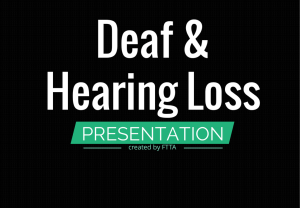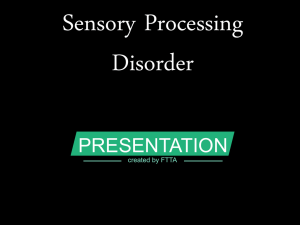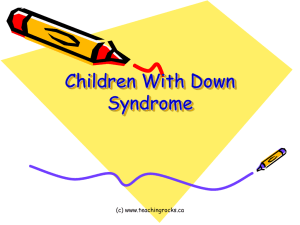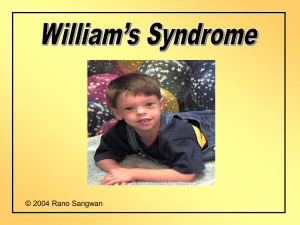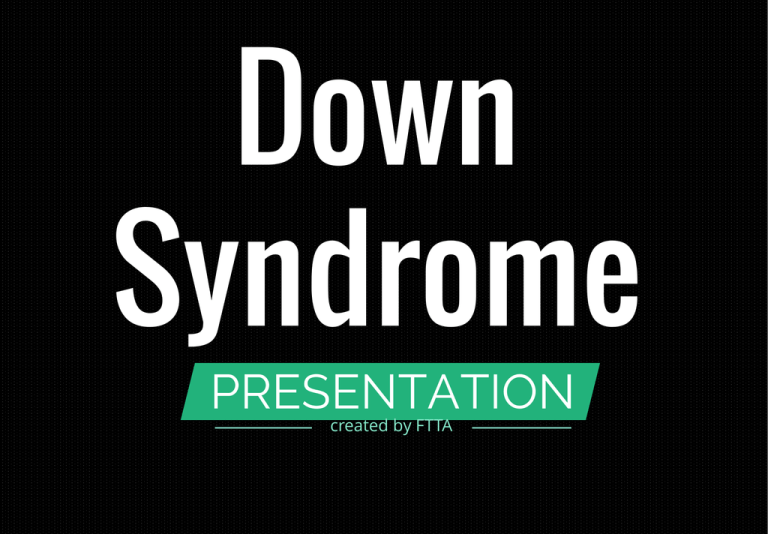
Down
Syndrome
PRESENTATION
created by FTTA
Disclaimer
Please note that FTTA presenters, lectures and staff are not
medical professionals. This information is designed to be
used for education assistants under the supervision of
professionals and some parts may be incorrect, outdated or
the authors’ opinion.
Down
Syndrome
Down Syndrome occurs because of a
chromosomal abnormality that happens while
the cells are pairing and dividing at conception.
It is the most common genetic condition where people have an extra set of chromosomes.
People with Down Syndrome all share similar, unique facial features.
FTTA
3
29
///
What is Down Syndrome?
Generally people have 46 chromosomes in each cell with 22 pairs and 2 sex
chromosomes.
While the egg begins to divide, each cell divides and so each cell will have the
same genetic code.
If the cells do not pair off correctly, an error called nondisjunction occurs.
47 chromosomes are now developing, duplicating itself and a baby with Down
Syndrome develops.
FTTA
4
29
/// How is DS
Diagnosed?
Pre-natal Diagnosis
Screening Test: estimates the risk of having
a baby with DS
Between 15 and 20 weeks gestation
“The Triple Screen” blood test
Ultrasound i.e. thickness of skin around neck
IS NOT AN ACCURATE DIAGNOISIS
Diagnostic Tests
Diagnostic Test: determines if baby actually has DS
Amniocentesis performed between 15 and 20 weeks gestation
Chorionic Villus Sampling (CVS) conducted between 8 and 12 weeks
If a baby is suspected
to have a
chromosomal
abnormality, a blood
test analysis is
conducted shortly
after birth
Percutaneous Umbilical Blood Sampling (PUBS) performed after 20 weeks
FTTA
5
29
Types of
Down Syndrome
Mosaic Down Syndrome
Trisomy 21
Most common form
affecting 94%
Chromosome aligns
with 21st pair of
chromosomes
(hence Trisomy 21)
Translocation Down
Syndrome
3-4% of cases,
FTTA
2-3%
A mosaic effect of cells that
have and have not divided
correctly.
People affected with
Mosaicism MAY be affected by
the syndrome
6
29
/// Common Facial
Characteristics
Epicanthal fold - Eyes that have a slant and
an extra fold of skin on the inner side
A thinker neck, or extra
fold of skin
Brushfield spots - Small
white flecks on the iris
Ears are generally smaller and tops may slightly fold
over and sit lower on the face
Smaller, flatter nose
Broader face
FTTA
7
29
Transverse palmer crease - Single crease
across the broader hand with a pinkie
/// Common
that may appear crooked
physical
characteristics
Low muscle tome and loose
ligaments
Big toes widely spaced
Range of associated medical conditions,
including vision and hearing problems
and reduced immune function
FTTA
Congenital heart defects found
in 50% from before birth
Smaller and or shorter limbs and smaller and chubbier fingers
8
29
SOME FACTS ///
Young mothers can have a child DS
It is not the age of the mother, but the health of her eggs that is the
factor.
Not all eggs age at the same rate
A woman is born with over one million eggs. Genetic, environmental, age of eggs and other factors all play an
impact on the health of the eggs.
It was once considered a high social status to have a child with DS
Women who had children in later years were often wealthy and naturally at a higher risk of having a child with DS.
1950’s movie star Mickey Rooney was rumoured to have DS
Mosaic Down Syndrome does not always affect intelligence unlike the other types of DS.
FTTA
9
29
Downs Syndrome
STATS
In Australia, babies born with DS is
approx 1:1100
Since 2007 around 270 babies a
year are born with DS
There are over 13,000 people with
DS in Australia
FTTA
Current life expectancy for a person with DS is around 60
10
29
///What is early intervention?
In WA, most babies born with Downs Syndrome are referred to the Disability Service Commission
to have an Individual and Family Services Program (IFSP) developed.
Occupational Therapy
Provides support for
infants and young
children with
developmental delays
or disabilities
Speech Therapy
Physiotherapy
FTTA
11
29
/// Developmental
Milestones
If it is expected, a child
by 5 will be walking,
toilet trained, dress
with minimal help and
feed themselves
FTTA
12
29
Visual Learners. Focus on using
///
Teaching
Strategies
visual processing and visual memory
skills
More is understood than is said
Classroom rules and behaviours can be
followed. Structure and routine are
important
Use shorter phrases and visual clues
Keep the expectations for behaviour
and attitude high, as with any other
child
FTTA
13
29
///
Functional
Curriculum
needs
When
1:1 teaching
learning
social skills
Small group work
Possible whole class
instruction
Repetition
Taking off jumper
of activities
skills are a
priority
is valuable
Recognising correct toilets
Eating lunch / recess at correct
Toileting
Contingency plan for
needs must be accidents
time
considered
Toilet trained
Walking out route so student
Modified
FTTA
understands how long it takes
Curriculum
14
Celebrate success…however small
29
You were being told to do
something you were unsure of?
///
How may you
act if…
Your language skills were not
developed enough to express your
concerns or views?
Children with DS like
structure. Refusal can
occur when trying to get
the child to try new things.
You did not understand why you have to
do something this new way that you do
not understand?
FTTA
This is because they resort
to doing what they know
is safe
You may appear
Stubborn! ///
15
29
What does
stubbornness
look like?
sitting
withdrawing
Not looking
Throwing
themselves
down
FTTA
pouting
16
29
///
Strategies for
“Stubbornness”
Start seeing the behaviour as resistance to the unknown
Discuss the
Prepare the
child for the
changes
upcoming
changes
Help child to
Social stories
feel safe with
new activity
FTTA
17
29
Inform student you are displeased
Structure
///
with voice and body language
Routine
Behaviour
Management
Strategies
Black and white rules
Explicit and clear expectations
Developmentally appropriate consequences
Consistency and follow through
CATCH THE STUDENT BEING GOOD!
FTTA
Strategies to alleviate resistance to change
18
29
Types of
Physical &
Medical
Conditions
Specific Learning Difficulties
Hearing
Eyesight
Immune system
Heart Defects
Speech and Language
Gross & fine motor skills
FTTA
19
29
Do lots of reading activities – this builds knowledge base
Allow extra time for response
///
for when their speech communication improves
Model what you want
Communication
Strategies
Poor listening
skills
Have visual cue cards for the child
to point to when communicating
Teach hand gestures for the child to
use when communicating. Makaton is
Having higher receptive
(understanding) skills than
expressive skills, frustration
can easily occur when not
understood
useful.
Ask child to show what they want
Encourage lots of speech and sounds –
Give clear and simple
spend at least 5 minutes a day talking
instructions one at a
with the student
time
Eye contact
FTTA
Do not allow other children to respond for the child
20
29
Hearing
implications
1
Delayed speech and language
2
Student may not notice
3
During hearing infections, loss of
Frequent colds and
upper respiratory
infections and small ear
canals can cause varying
degrees of hearing loss
FTTA
development
instructions being given in noisy
classroom
hearing can be up to 40 db in one
day. Playground siren may not be
heard
4
Hyperacusis: over-sensitive to
5
Possible refusal to join noisy
loud noises
situations such as assembly
21
29
Hearing
strategies
FTTA
1
Sit student close to teacher and not
2
‘Face-to-face’ instructions
3
Clear language suited for
4
Include visual cues and signing
5
Reduce background noise or
looking into bright light
developmental level of child
move student to quieter part of
room. Headphones.
22
29
///
Behaviours to watch
Implications for
Eyesight
Impaired vision
is very
common
for include:
Tilting head
too far back
Regular eye
Seating
checks
position
Working too
close to a
book
Ensure
glasses are
worn
Very sensitive
to sun
exposure
FTTA
Hat and
Gradual
sunglasses
deterioration of
worn outside
eye tissue
23
29
Immune
System
Implications
& Strategies
Illness such as upper
respiratory infections are
more common
Frequent use of antibiotics
may affect toileting
An underdeveloped
immune system is
common
FTTA
24
29
Heart Defects
Found in up to
40% of students
Heart defects are
operable
implications
May tire easily
Some physical activities can be
harder for full participation
strategies
Obtain current medical information
A ‘pigeon chest’ is no need for concern
FTTA
Monitor physical activities and
allow student to sit out when
required
25
29
Poor muscle tone
Poor motor planning
Possible ‘flat’ footed
///Implications &
strategies for
Gross
Motor Skills
Floppy & loose jointed
Difficulties with co-ordination
and gait
Difficulty problem solving
with using equipment
May have less stamina than peers
Encourage
participation
Make games
friendly
FTTA
Model and talk
Assist child verbally
student through
and physically while
problem
gaining confidence
with play equipment
Allow for extra
rest time
Ensure orthotic
devices are in
correct shoe
26
29
Poor dexterity
and manipulation
skills
Songs and games
Fine Motor
Skills
strategies &
implications
Difficulty cutting,
handwriting etc
Too small for
furniture, box
under feet
that develop muscle
Messy writing
strength in arms,
picture
wrists, hands and
fingers - pictures
FTTA
‘Key Steps’
program
Extra structured
handwriting program
27
29
High level of supervision in areas of risk
Toilet procedures may need extra
monitoring
///
Response plan if student leaves the school
Duty of
care
grounds
Poor understanding of boundaries and other
concepts. Show exactly where student can play
Greater
responsibility for the
Protective Behaviours program
Mandatory reporting
Swimming lessons – does
welfare of the
student is needed
student need ear plugs, can they
hear with swim cap, extra
supervision in bathrooms,
assistance with clothing?
FTTA
Buddy system
Monitor and remind student about
weather needs i.e. jumper, hat
28
29
Want to know more?
http://www.genetics.edu.au/Publications-and-Resources/Genetics-FactSheets/FactSheet28/view
http://www.thesebrokenvases.com/2010/10/physical-characteristics-of-down.html
www.downsyndrome.org.au/down_syndrome_popuation_statics.html
http://www.australianreview.net/digest/2012/05/spandagou.html
www.ndsccenter.org/resources/general-information/ds-news-articles/stubborn-isas-stubborn-does/
http://www.dswaasn.au/what-is-down-syndrome.html
http://www.nads.org/pages_news/fact.html
FTTA
29
29

